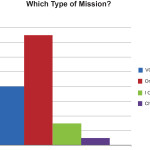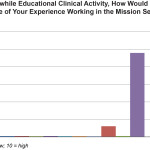Educator's Podium
Humanitarian Missions as an Adjunct to Education
W. Howard McAlister, OD, MA, MPH, FAAO, Jeffrey L. Weaver, OD, MS, FAAO, and Timothy A. Wingert, OD, FAAO
It has been argued that participation in humanitarian missions is beneficial for students. Such missions may provide distinct clinical encounters as well as other educational opportunities such as experiencing global health systems, diverse cultures and medical logistical planning. For example, international humanitarian missions have been demonstrated to be useful in otolaryngology residency training, providing surgical and clinical exposure, and broadening participants’ worldview.1 Furthermore, such experience may enhance cultural competence2 ― the ability of medical providers and organizations to effectively deliver healthcare services that meet the social, cultural and linguistic needs of patients ― a stated goal of ASCO and its member institutions. Students and residents are largely convinced of the benefits of their mission experiences. In a survey of surgical residents, all believed that participation in a humanitarian mission during residency was a positive part of their training. Specifically, they believed that missions helped them to develop as surgeons and improved their awareness of global health care and cultural competence.3 Other surveys of students and residents have produced similar results. For example, New York University general surgery residents indicated strong interest in acquiring international experience despite barriers such as scheduling conflicts and financial concerns.4
Despite these points of view, some faculty question the educational benefit of humanitarian missions, citing, among other factors, that participation results in considerable absence from classroom, laboratory and clinical instruction. To gain insight into this issue, we investigated the experiences of optometry students who recently participated in international humanitarian mission trips. We created a Humanitarian Missions Survey instrument and mailed it with self-addressed stamped return envelopes to 205 graduates of the University of Missouri – St. Louis College of Optometry. The recipients comprised the most recent five years’ graduates of the college. The survey (Appendix A) asked subjects whether they had participated in a mission as an optometry student and included questions about the length and type of mission, the number of students/doctors on the mission team, and how many patients and which conditions were seen. The survey also included questions designed to determine whether mission participants found their experience to be valuable.
Results of the Survey
Of the 205 surveys mailed, 73 completed surveys were returned, for a response rate of 36%. Of the 73 respondents to the survey, 27 (37%) reported they had participated in a mission while an optometry student. Results are presented in Figures 1-8. According to the results, participation in a humanitarian mission primarily involved three organizations:
- Volunteer Optometric Services to Humanity (VOSH) International. Its mission is to facilitate the provision of care worldwide where it is not affordable or obtainable. VOSH International consists of optometrists, opticians, ophthalmologists, medical personnel and trained laypersons who have no political or religious agenda.
- OneSight, a Luxottica Group Foundation. This is a family of charitable vision care programs dedicated to improving the vision of people around the world through outreach, research and education.
- I CARE International. This group’s goal is to improve the quality of life by providing the gift of better vision and health. It is a non-religious, non-political, organization that consists of volunteer optometrists and other professionals.
 Figure 1. Click to enlarge |
 Figure 2. Click to enlarge |
 Figure 3. Click to enlarge |
 Figure 4. Click to enlarge |
 Figure 5. Click to enlarge |
 Figure 6. Click to enlarge |
 Figure 7. Click to enlarge |
 Figure 8. Click to enlarge |
Based on the findings of this survey, the average clinical experience associated with a humanitarian mission is robust. With a typical team of six optometrists and four students, 820 personal patient encounters per mission, and a large number and wide array of refractive and disease conditions diagnosed, the clinical experience of the survey respondents likely exceeded the scope of most externships. When asked to rate their experience on a scale of 1-10, with 10 being the best, 24 of 27 (89%) of the respondents chose 10. Comments submitted with the survey, a sampling of which is shown in Appendix B, were very positive.
It has been suggested that the benefits of humanitarian missions warrant consideration as international electives,5 or that participation in a humanitarian mission could be credited as part of a residency or externship program.6 Further study of the potential benefits or drawbacks of humanitarian missions for optometry students and residents is warranted, and surveys designed to canvass students’ testimony to their experiences can be a useful approach.
References
- Adkins L, Saunders J, Grant N. International humanitarian mission trips during otolaryngology residency. Presented at the 117th Annual Meeting of the Trilogical Society, May 14-18, 2014, Las Vegas, NV.
- Betancourt JR, Green AR, Carrillo J E 2002. Cultural competence in health care: emerging frameworks and practical approaches. New York: The Commonwealth Fund.
- Aziz SR, Ziccardi VB, Chuang SK. Survey of residents who have participated in humanitarian medical missions. J Oral Maxillofac Surg. 2012;70(2):e147-57. doi: 10.1016/j.joms.2011.10.007.
- Powell AC, Mueller C, Kingham P, Berman R, Pachter HL, Hopkins MA. International experience, electives, and volunteerism in surgical training: a survey of resident interest. J Am Coll Surg. 2007 Jul; 205(1):162-8. Epub 2007 May 17.
- Jensen S, Tadlock MD, Douglas T, Provencher M, Ignacio RC Jr. Integration of surgical residency training with US military humanitarian missions. J Surg Educ. 2015 Sep-Oct;72(5):898-903.
- Durning SJ, Massine RE, Ender PT. Value of humanitarian assistance missions in residency. Acad Med. 2003 May;78(5):546.

Appendix B. Click to enlarge

Appendix A. Click to enlarge




